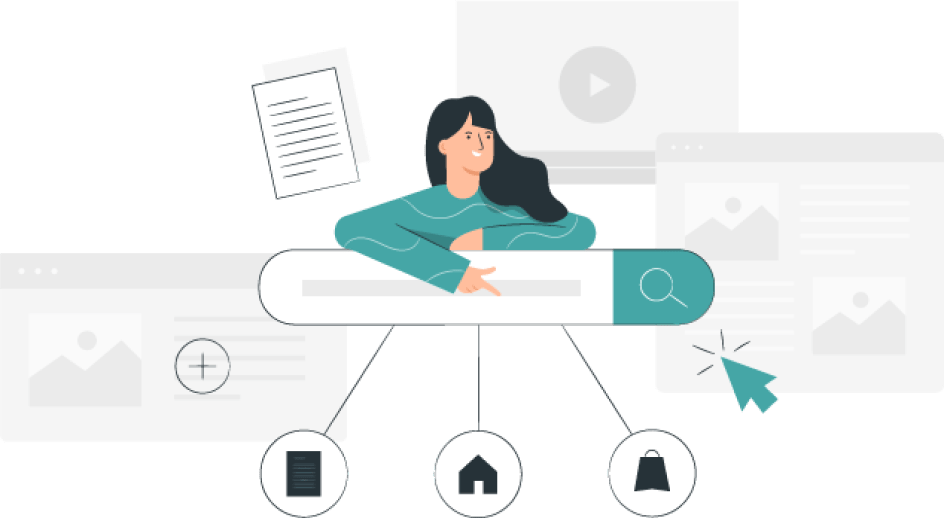The Importance of User Intent in Content Creation
Digital marketing world is customer-centric. The way we search for information on Google has evolved and now we ask specific questions using specific keywords. Google’s algorithm was once “robotic”. Nowadays, search queries will receive exactly what they asked for as the algorithm is more focused on the user’s intent. Providing your customers exactly what they desire is the key to a successful business. Search engines have the same mindset. They want to provide the correct answer quickly and accurately. Understanding user intent is a decisive factor in Search Engine Optimization (SEO) to get a higher ranking and improve traffic through your website.
In this article, we will provide all the information you need to understand how people search on the internet, their intentions, and how to implement a focused content on user intent. Follow along for useful information and best practices that will help you grow your business.
What is User Intent?
User Intent represents the objective that someone has in mind when typing a search query in Google. Some users are interested in purchasing a product or service, others are looking for information on a specific topic, and some might need details or want to connect with a company or individual.
The easiest way to understand how to set in place your content marketing strategy is to think of it as you think of your product. If you develop a product without knowing your target audience, then, probably, your product is going to fail or have a poor performance. Content creation implies the same process of thinking. We truly believe that you should not develop online content without knowing what and whose goals it will help satisfy.
As you are looking to build content around user intent, we recommend you to follow the tips below.
Identifying User Intent

A crucial factor in creating your content plan, improving existing content, or writing special content, is to know and understand the fundamental categories of intent queries. The audience is usually driven by three types of user intent. Keep in mind that your target audience can fit in one or more of the following categories.
- Informational Intent – when a person wants to grab knowledge about a specific topic;
- Navigational Intent – when a person is looking for a specific source, page, or website;
- Transactional Intent– when a person is looking to buy a product or a service.
User intent differs from person to person and might change during their user journey. For example, one person can start with an informational intent and might change their intent into a transactional one.
Tailoring your content for one of these types of intent is a must. We recommend looking at the keywords people are using in their search queries. Keywords are revealing the particular type of user intent. A simple example is when someone types “buy website domain” into search engines, their intent is transactional. When someone looks up “how to write articles for SEO”, the intent is informational.
When you have doubts about what intent is behind a keyword, type the query into Google and analyze what kind of articles come up.
What Are the Types of User Intent?
The best way to identify the type of user intent behind a keyword, search for the keyword yourself and look at the top results. Evaluate the common trait of the articles and if all of the results are akin, it is the proof of a universal user intent. When the results are mixed, examine whether the keyword fits into your marketing strategy or not.
Informational Intent
The user is interested in collecting information on a specific topic or product, before moving to the next action. The audience wants to learn more about something or they are looking to solve a problem. Typically, the search query is question-based, such as where, when, how, why, what, and who. These searches use generic keywords and sum up 80% of the search volume.
Informational search is also known as “know query”. They are a great tool for developing high-quality content that provides relevant and valuable information. We suggest to include in your content plan detailed blog posts, how-to or video tutorials, infographics, or even a step-by-step guide. The best way to fulfil the user’s needs is to provide honest, expert information as a response to common queries in your business field. By adding a simple call to action such as learn more, find more, discover more, users can learn about your brand, products, or services.
Navigational Intent
Known as “go queries”, these types of searches are the most common ones. The user is looking for a specific page, website, or resource. Writing content for navigational intent is a great way to bring high-value traffic to your website. When a user is typing keywords such as “best”, “[X] location” or a particular brand, they want to find information on a specific source.
If your website fits the needs of the users intent, it will bring them to your online sales funnel by providing them with the needed information. Therefore, navigational intent is relevant only when a user wants to visit your site, they use semi-generic keywords and represent 10% of the search volume.
Transactional Intent
The “Do searches” have the motivation for completing a transaction. If you identify your users intent as transactional, you can optimize your content to match their course of action. Don’t try to push products on them, but create content that emphasizes the strengths of your products or services.
Transactional intent searches may include keywords such as “buy”, “price” or “quote”. The target audience performing this type of query is at the end of the sales funnel and will be converted into buyers.
These searches are high-efficiency searches, use specific keywords, and account for 10% of the search volume.
How People Search: Understanding User Intent

Whenever a user is conducting a query in search engines, he finds himself in a search commercial intent funnel or sales funnel. There are three stages of this funnel: awareness, discovery, and purchase. In the awareness stage and discovery stage, the search intent is either informational or navigational. They look for specific topics, companies, or products/services. In the purchase stage, the intent is transactional. The users did their research, collected all the relevant information and they are ready to buy.
To better understand how the user intent process is happening, we split it into four simple steps:
- Search Query: this process starts when a query is conducted on the search engine. The query can be navigational, informational, or transactional. At the beginning of the search, the users have in mind an image of what type of results they expect.
- The Search Results Page: users expect the results to match the image they had in mind.
- Clicking Time: after seeing the results, users have an intent in mind when they click on the displayed results. If the title and the description of the pages in SERP are aligned with their intent, they will click on the link.
- View the Page: after clicking on the page that most appeals to them, the users expect the exact information they have envisioned.
Answering the needs of your audience and meeting their expectations through user intent is the brick and mortar of every successful marketing campaign. Now that you understand what user intent is, you can identify and classify it, we think it is a great moment to start incorporating user search intent strategies into your SEO and content marketing campaigns to fulfil the search goals of your audience.
Discovering User Intent
We have created a list of tools that will help you identify user intent. Our recommendations are to take your time for this investigation to ensure the success of your content strategy and achieve the best results. Here are a few easy to use platforms to help you:
- People Also Ask – after you perform a search query on any topic on Google, after the first result, you will see the People Also Ask box. This function will help you see the top questions about the searched topic. You can also dig deeper into related questions.

- Searches Related To – another Google’s feature at the bottom of the SERP (search engine results page) that will give you more insights about user intent on related terms and related topics.

- Answer the Public – if you go to Answer the Public and type a target keyword related to your marketing plan or company, you will receive the who, what, when, and how questions people are asking about the topic.
- Keyword Tool – to generate data about the search volume and competition on the keywords you plan to use in your strategy, go to KeywordTool.
- Mention Tool – use Mention to see your online brand mentions. This will help you identify the simple questions people are asking about your company and it will give you a strat on creating pieces of content that answer their questions.
Why is User Intent Important?
A study done by Google shows that 51% of smartphone users have bought from a different brand than the one they initially intended because they found useful information from a competitor. Google’s end goal is to answer fast and accurate to any query or question without making the user scroll or perform another search.
User intent marketing strategy is crucial not only for your SEO but also for your revenue. By keeping in mind the facts stated above, we would like to share with your some of the benefits you will enjoy after including user intent in your strategy:
- Improved SEO ranking – when search engines find your content to be relevant to search queries, your website will be perceived as a trusted source, will increase your website’s authority and organic traffic;
- Increase visibility in search engines – take advantage and be ahead of your competition;
- Relevance – when your content matches the intent of your users, your business becomes the desired search and improves the ranking factor;
- Awareness – with improved SEO ranking, visibility, and relevance, your business is going to gain notoriety and therefore, increase brand awareness among users;
- Increase website traffic – when your content is relevant, more people will visit your website, and the chances to convert them into customers are higher;
- Revenue – people will choose your business instead of your competitors when they find all the information they need on your website.
Applying User Intent to Your Content Strategy
The journey of a user will change throughout the sales funnel. As we mentioned before, there are three stages to the funnel and all of them need custom content. Knowing what type of content to deliver to them based on their position in the sales funnel, is a very important fact that will determine your strategy’s success.
When your users are at the top of the funnel, they are in the awareness stage. In this stage, they are looking for general information, searching for answers, data and to educate themselves on a specific topic. For the awareness stage, the most important pieces of content are ebooks, case studies, white papers, blog posts, educational videos, webinars, how-to and podcasts, industry research, event coverage, etc.
In the middle of the funnel, your users are in the discovery or evaluation stage when they are thinking about connecting with your company or not. These are informational searches. For this stage, you can create a FAQ page about your company, product manuals, schedule a product demonstration, send them a demo. Encourage your users to interact with you and use calls to action such as “sign up for a free demo” or “schedule a call”.
The bottom of the funnel is where your target audience has a high intent to purchase. In this stage, your goal is to convert the user into a buyer. You can offer them discounts or coupons/vouchers, free trials. Be specific and tell your users exactly what to do with your call to action. Use words such as “buy”, “purchase”, “get your discount”, “get started now”.
Evaluate How Well, Existing Content Supports User Intent

Finding out where you stand and where your content fails to answer your target audience’s needs, we recommend starting by taking a look at your top-performing keywords in Google Analytics.
We suggest analyzing top keywords phrases that will lead to information about users intent. For example, if one of your top keywords includes a transactional word such as “buy” and the user is redirected to a general page where he can’t complete a purchase, then their goal cannot be reached within your website. Our recommendation is to reconsider your strategy and align it to your audience’s goals.
In case your content is aligned with the user intent but it is not performing as good as you expect, we suggest digging deeper into your keywords. They might be the biggest issue. Change your keywords to align better with your page’s content. When you sell something, make sure your keywords are transactional and when you help people learn about a focused topic, your keywords must be informational or navigational.
How to Optimize Your Content for User Intent?
The best way to optimize your content is to “walk into your user’s shoes” and conduct a content gap analysis. We recommend to start by asking yourself: Does my content do what I need it to do? Is my content helpful and engaging? Does my content fulfil my goals and answer my questions?
Make sure your content is a broad topic coverage, comprehensive, and delivers what your target audience wants.
Your content is created to attract your target audience’s attention. A good way to start creating relevant content for user intent is to take a look at Google Search Console to identify the most frequent queries. By analyzing them, you can forecast your user’s informational intent, therefore you can now optimize your content to improve your traffic website and bring forward to your audience exactly what they expect.
Perform keyword research to identify the keywords your audience is using on Google for search queries. A properly optimized content that your audience likes will bring more engagement to your business and more likely for people to share your content. This will improve your search engine rankings and traffic.
We suggest using Buzzsumo, Answer the Public, or Google Autosuggest for inspiration and to generate keyword ideas.
Research other related keywords, using free tools like: Keyword Shitter, Google Keyword Planner, Ubersuggest, Google Trends, etc.
High-quality content that matches your user’s intent must include the best SEO practices. Introduce the focus topic properly by writing what’s all about and why it’s vital to your audience. Use subtitles, as they are keywords carriers and they are relevant to your SEO strategy. In content marketing, your subtitles break the content and make it more appealing to your audience and easier to read and navigate.
Understanding the buyer’s journey is the last step in content creation. Craft your content based on the stages from the sales funnel and your user’s goals. Use the right call to action and keywords to fit with the user’s stages.
User experience is also an important part of your strategy. Pay attention if your website is easily accessible and helpful. Take into consideration some technical aspects to improve the user experience:
- Site speed – 47% of customers expect a page to load in less than 2 seconds. Otherwise, you risk losing traffic and conversions.
- User friendly – how easy is your website to navigate? Your menu bars and page navigation is the key to successful site experience.
- Responsive design – your website must be optimized for mobile users as well. Make sure you implemented the responsive design throughout your website.
Our Expertise
Optimized content is very important not only for SEO purposes but for a better connection with your audience. If you understand the user intent and convert that into your content, your business will grow in the digital environment. More researched and informed content will bring you valuable and relevant connections with your target audience.
When it comes to content optimization for user intent, we start with a strong content analysis regarding our target audience, demographics, and user behaviour. Based on the findings we can adapt the content of each landing page, add the right call to actions, and create useful pages that might miss from the website.
You can read this case study to find out more about our approach regarding SEO, marketing strategy, and the results of our eCommerce client.
Contact us if you don’t know where to start and let’s bring your business to new heights.
Frequently Asked Questions
Attract qualified and relevant audiences to your website, reduce bounce rate, increase page views, reach a wider audience, rank higher in SERP.
In case you are having trouble in finding out your audience’s intent, just ask them directly. Go to your social media accounts and ask them what they want or need.
We recommend you to go beyond the keywords and think from a user intent point of view. Keywords are just words, but where they drive at is the main focal point.
Take a look at your organic traffic from Google Analytics and see what kind of words your audience uses to find your site.